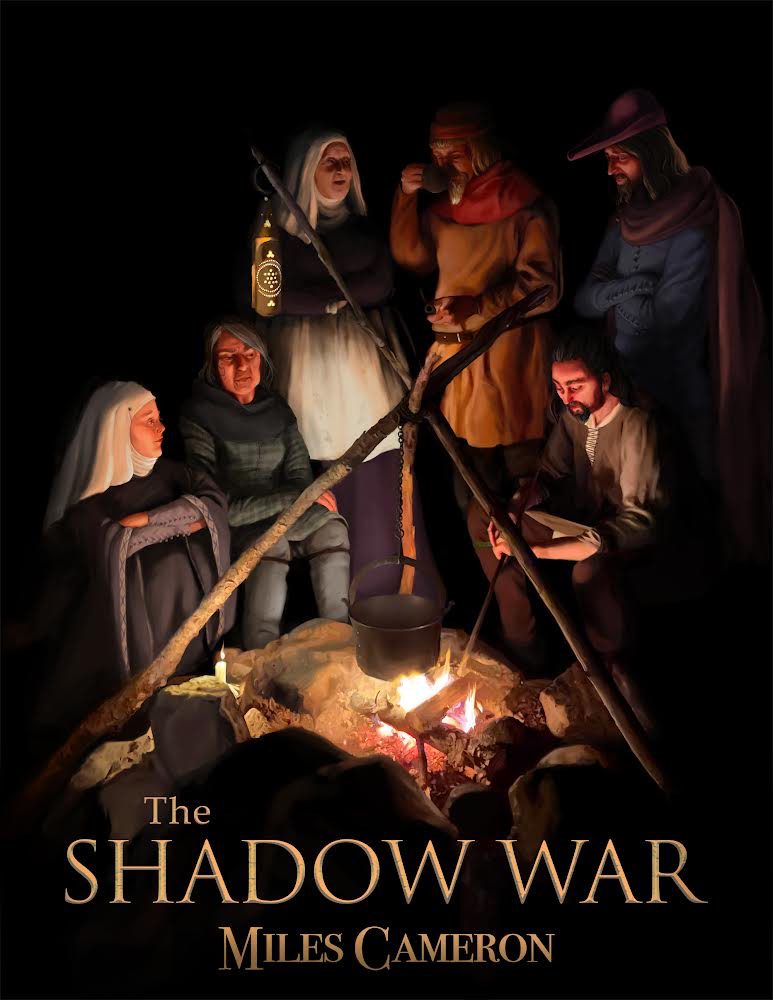
When people ask me about the impact of reenacting on my books, they almost inevitably follow up with a question about swords and armour. They’re often great questions, and I’m always happy to answer them; I’ve taken a pretty deep dive into a couple of periods and I think I have developed some interesting ‘general usage’ theories of martial arts and warfare. At the end, there’s a nice picture of a fantastic original sword that helped inspire the book Cold Iron.
But the thing is that weapons and armour are actually the least important aspects of reenacting. Even the most keen and hardened warrior (if such people actually ever existed; modern psychology suggests that warriors are either keen or veterans, never both, but that’s another story) only engaged in combat a few days a year, whereas cooking and sleeping and keeping clean happened every day.
The remarkable thing about cooking and cleaning and sleeping and living is not the items you need to do them. You can, with a little online research, reach out and buy a 14th century fry pan and a fourteenth century kettle, and some other very useful kitchen tools. A little more research, and you can come up with recipes and even whole cook books of Medieval food, whether Norse or English, French or Italian.
Even with swords and knives, you can buy an excellent blade; cook’s knives, eating knives, daggers, broadswords.
Ultimately, recreating the past, or understanding a fantasy world, is more about containers than it is about weapons.
Try and find a decent, correct scabbard.
Or a net bag to carry all the vegetables you plan to eat.
Net bags? Did they have those?
What did meat come from, at the butcher’s? What was it wrapped in in 1380? How did split peas come, or dried fish? Flour? How the heck do you keep flour dry when you travel?
Let’s cut to the chase. In the past, most people had to supply their own packaging. Women went to market with baskets and jars and linen bags and probably leaves and scraps of bark too. Men who traveled (often the wealthy) had elaborate sets of equipment not entirely unlike picnic sets to carry food and drink and pots and pans. But even those sets usually came inside a container, and the container was a basket.

Wholesalers provided food already stored in baskets; remember when you bought blueberries and strawberries in baskets? (I do. I’m old.) Most market towns had a ‘women’s’ industry in just making baskets; in early North America, First Nations people made (superb) baskets. They still do. All of the baskets my Medieval group uses are Mohawk baskets made on the Tyendinaga reserve. We use their baskets because they are actual, usable baskets, which look like the ones in Medieval art but will last and last.
We make our own linen bags, and we can never get enough of them. It’s worth knowing that linen was often woven at home, by women, and it cost time and effort, so making little bags was probably not all that common.  To the left is the cover of Ulrich’s brilliant ‘Midwife’s Tale’, perhaps the most important history book I’ve ever read. Lots of it is about women’s economy in the late 18th century. Anyone writing fantasy should read it; anyone with an interest in the lives of women in the past should read it. It includes details of the internal economy of a house; it even includes details on weaving linen. Just remember, when a reenactor, or a fantasy character, makes a bag out of linen… how many hours of someone’s work that little bag may represent.
To the left is the cover of Ulrich’s brilliant ‘Midwife’s Tale’, perhaps the most important history book I’ve ever read. Lots of it is about women’s economy in the late 18th century. Anyone writing fantasy should read it; anyone with an interest in the lives of women in the past should read it. It includes details of the internal economy of a house; it even includes details on weaving linen. Just remember, when a reenactor, or a fantasy character, makes a bag out of linen… how many hours of someone’s work that little bag may represent.
In Northern Europe and North America, people made bark containers; usually birchbark, but sometimes elm. Birch bark was as prevalent in Poland as in Canada; Elm bark was equally popular, and I suspect that in England, the bark of ash and other trees was used instead.
Both of these are bark containers from Poland.
They didn’t wrap things is paper, at least right away. Large scale, commercially successful paper manufacture in a 14th century thing, but that was a fine quality rag paper for printing, and the whole idea of throw-away paper… is not a Medieval idea. Throw-away? Even the baskets can be reused. Linen bags can be washed, better yet, boiled. Netting can be used to hold bulk; woven nets of flax or other fiber (includign bark fiber) were used to hold bulk vegetables and all sorts of other things. When we’re in the woods, we usually use net bags to hold kale and other delectable greenery.
OK, I’m not a big Kale fan. I admit it. In the Middle Ages, they ate it, as long as ‘they’ includes horses.
I’ll finish with leather bags. That’s mine in the top illustration; I’m eating lunch with my Compagnia at the top of Myer’s Hill in the Eastern Adirondacks. That bag is based on a find in the Thames; it has several pockets, and it would have cost real money even in 1380. It allows me to keep all my gear separate; my fire kit (there’s another blog) and my candles and my razor and my little mirror and my eating kit and…
And a fortune in small, carefully wrought items. Why do adventurers not carry these? And why aren’t they the most valuable possession? You can always kill some guy and take his sword, right? But try and find a bag full of useful objects in the outdoors. Try getting a really good dry snug fire kit. I lost mine on Camino in Spain. Still sad.
My point is, though, that your leather shoulder bag is your lifeline; your survival kit. Also your purse. Mine holds some food, always, and a precious wax candle for starting a fire, and other secrets… Remember that in Medieval clothes, no one has pockets. And remember that when you say ‘Oh, in my world they have pockets’ you need to know why people didn’t have pockets in the past…
Alright. that’s enough for today. I’ll stop.
My latest novel is called ‘Cold Iron’ and it is out August 30th in the UK. This is (exactly) what Aranthur’s sword looks like. It is, (in my novel), an artifact of the ancient First Empire; a long sword that has a complex hilt. I take great joy is learning about the complexities of what museum professionals call ‘Material Culture’ because in understanding these things, be they linen bed sheets or swords, I come to understand the nuts and bolts that hold a culture together.





Would you consider doing another post on what exactly is in your leather bag? I am incredibly curious now.
You will get a bit (but just a little bit) on how soldiers carried things in Babylonia and Fars in the Long Sixth Century (BC!) in my Doktorarbeit.
Good as always
Its interesting to note that Otzi the ice man kept his fire kit in a flat belt purse., in effect a small “fanny pack” as yanks call them.. To pack a fanny would lead to many.. Intersting moments over, which he wore inside his clothes.
Mum had a wicker “flower basket” that still going strong after 40 odd years of service for shopping, carryingbthings to and from history events and many other functions.
As you say when one has to make most things yourself you want things to last and if there’s a problem it needs it.. Mend it..
Ps where did you get your info on the leather bag found in London. I’m not familiar with it. Thanks